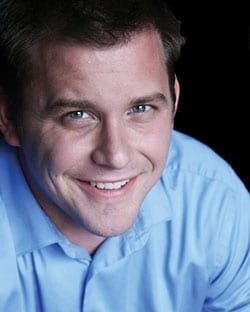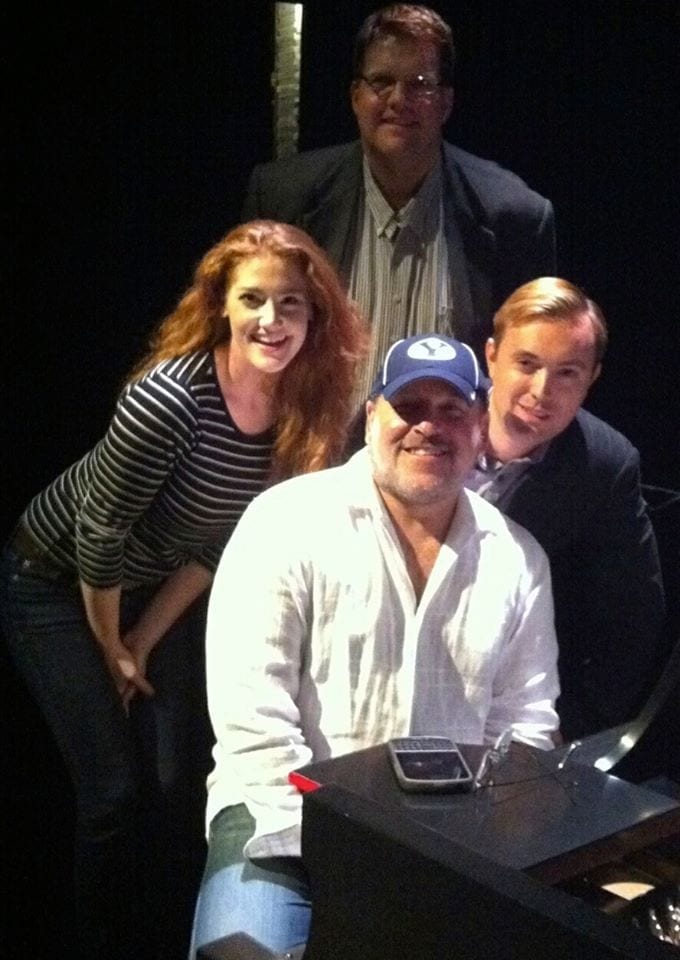CEDAR CITY — Few things capture the feel of the Renaissance as much as a greenshow, and few greenshows can compare to Utah Shakespeare Festival’s. One of my earliest theatrical memories is sitting on the grass in front of the stage watching the performers of the Greenshow dance around a maypole. To learn about the secret to the Greenshow’s staying power and accessibility, I interviewed this year’s co-director, Joshua Stavros.
UTBA: What’s the purpose of the Greenshow at the Utah Shakespeare Festival?
Stavros: With my co-director, Fred [Adams], that was one of the things we talked about very early on. He said that when the Greenshow was conceived, we wanted something to serve as a transition between people traveling to Cedar City and seeing a play. Fred always said, “It’s a way to disconnect from the chrome and the asphalt and just relax and enjoy coming to Cedar City before they go in and enjoy a play. It serves as this buffer.” He felt—and I agree—that it really prepared people mentally to enjoy the theater rather than rushing to get tickets and worry about parking and all those things. There was this 40-minute “in-between” that the Greenshow served. And it’s a chance to showcase additional artists in terms of music and dance. As it was originally conceived it was all live musicians and dancers, and we’re trying to get back to that as much as we can now. But it has an Old English, Shakespearean feel that we’ve managed to keep in a lot of ways, but we’ve also managed to push in a lot of ways, too.

Jared Howelton (left) and James Sanders as Featured Performers in the Utah Shakespeare Festival’s 2014 production of The Greenshow. (Photo by Karl Hugh. Copyright Utah Shakespeare Festival 2014.)
UTBA: Why are there multiple versions of the Greenshow every year?
Stavros: That’s a great question. Because we’re a repertory theater, we do multiple shows at a time in the Adams Theater and the Randall Theater. You can come for three days and see six plays, and we felt that that model served itself well for the Greenshow. Because if someone’s coming down for three days to see the plays and all three nights it’s the same Greenshow, they’re less likely to attend three times than if there’s a different show every nights.
UTBA: So how many versions of the Greenshow are there this year?
Stavros: This year there are three. We’ve got an English night that plays with Henry IV [Part 1]. That feels the most traditional, I think. If your audience has been coming for years and think of what a Renaissance Greenshow might be, that’s definitely English night. Opposite Measure for Measure we have Scottish night, which is still a little traditional, but pushes it in a lot of fun ways. The Highland Games are particularly interesting. And then opposite Comedy of Errors we have our Irish Pub Night, and that’s probably the least traditional. It’s more of a concert setting with great Irish music and dance. We have four live musicians that night, rather than just one or two.

A scene from the Utah Shakespeare Festival’s 2014 production of The Greenshow. (Photo by Karl Hugh. Copyright Utah Shakespeare Festival 2014.)
UTBA: You say that Irish Night is more of a concert. But in all of the versions of the Greenshow there is singing and dancing. How do you choose the song that the actors sing? Where do these songs come from?
Stavros: This year we looked at our favorite songs. One of our musicians has done the Greenshow for a number of years and is really a connoisseur of these Irish and Scottish songs in particular. So, over the winter we listened to a ton of different songs and picked what we liked. Most of them are traditional songs of folk tunes that have been recorded and re-recorded by really talented artists through the years. So, you can find different versions of them. We found the ones we liked and thought would work well together. One of the things that Fred and I talked about as we planned the Greenshow was that we really wanted to bring back some fan favorites in terms of certain dances and certain songs. The two biggest dances that he wanted to bring back were the egg dance and the sword dance. Sometimes we were looking for songs and we thought, “Oh, this will work well with that dance,” or, “This will work well for this one,” or, “This is a really fun thing for English Night.” Over the course of the winter we put a rough song list together and put it into a script in terms of a set list. Then when the company arrived we sat down with our music director and choreographer and went through it with them and made sure that it worked for them. Then we brought the actors on and put it all together.

Hilary Stavros as a Musician in the Utah Shakespeare Festival’s 2014 production of The Greenshow. (Photo by Karl Hugh. Copyright Utah Shakespeare Festival 2014.)
UTBA: You worked with Fred Adams, who of course is the Festival founder, and is a living legend in Cedar City. You worked with him co-directing the Greenshow this year. Describe what that was like.
Stavros: It was incredible. Fred is one of the nicest people you’ll ever meet. He’s brilliant for a thousand reasons. He gets people. He just gets people. His wife was the original conceiver of the Greenshow 53 years ago. So, he’s been an integral part of it, even though he had never directed it. We worked together on A Midsummer Night’s Dream—he was the director and I was his assistant director in 2011. But one of the things I was looking forward to was creating a vision together as co-directors. I was a little apprehensive before we sat there. I certainly had my ideas of what the Greenshow needed to be and changes we needed to make, and I was hoping that he felt the same way. I was so excited that first day when we sat down in January. We were on exactly the same page. We both felt over the course of the last few years some really great things had happened. There were some directions that Peter Sham (the previous director) and his wife Kirsten took it. We could have never done what we did this year if they hadn’t taken the risks and gone the direction they had gone. But Fred and I were both on the same page on style, speed, pace, and all that stuff. When working with him, he would say, “I know people love this song,” or he would say something about a song or dance. I would say, “I don’t really get it,” just because I hadn’t seen it before. He would say, “Nope. Trust me. We’ve been here before. I know they’ll love it.” And he’s right. I’ve been here 12 years, and he’s been here 53, and this amalgam of that together has just been really fun. And we’ve had incredible designers here. Paula Trimpey, our scenic and costume designer; Christine Kellogg, our amazing choreographer; and Michael Gribbin, who was the music director for Into the Woods, was also our music director. So, the cast sounds good. They look good. They dance well. It’s awesome. I couldn’t be happier.

Tyler Sparacio (left, then clockwise) Josh Durfey, James Sanders, and Jared Howelton as Featured Performers in the Utah Shakespeare Festival’s 2014 production of The Greenshow. (Photo by Karl Hugh. Copyright Utah Shakespeare Festival 2014.)
UTBA: You said that you started planning this in January, and you talked about picking a song list and creating a script around some old favorites and some new directions. But how could you describe shortly how creating the Greenshow varies from creating a traditional play or musical?
Stavros: The biggest difference is in the plot. The Greenshow, as we conceived it, has no distinct plot. There is character, and there is story. But it comes across in a different way than a tradition rising action-climax-falling action play structure. It comes together more like a devised theatre piece in that there is no script initially, and it just sort of morphs and grows as it interacts with the skill set of the performers and the needs of the audience. It was fun even the first few days—even though we had their head shots and resumes—assessing actors’ special skills and what they like to do and retweaking the show after we saw them in the room. Even in that first week we were adjusting after we saw them in the room and rehearsals had started.
UTBA: Fascinating. What do you do the rest of the year at the Utah Shakespeare Festival?
Stavros: The rest of the year I am the associate education director. The education department—helmed by Michael Bahr—has a number of programs regionally, many of which specifically apply to the state of Utah. We take a touring production out every February through April of a 75-minute version of a Shakespeare play. Michael and I serve essentially as the co-producers of that. We have a huge high school Shakespeare competition every October that brings 3,000 kids from 120 schools in 6 states to Cedar City for three days to compete for scholarships and other awards. We have summer classes and local youth theatre productions throughout the year. We are also responsible for the backstage tours and repertory magic—the fun Festival experience stuff that goes on here—as well as the orientations and seminars that you get as part of your Shakespeare Festival experience. That’s where the Greenshow and education—in terms of my world— have melded this year. It’s all part of this great Festival experience. You come and see a play, but a ticket to the Shakespeare Festival is more than a ticket to the play. Whether you’re seeing an orientation before or a later seminar after or an actor or a costume or prop seminar, it’s all part of that extra “oomph” that makes an evening or a week at the Shakespeare Festival more than just an evening of theatre.
UTBA: Excellent. Thank you for your time. I caught the Greenshow tonight, and I really enjoyed it.
Stavros: Thanks.
UTBA: And I’m catching one tonight, too.





